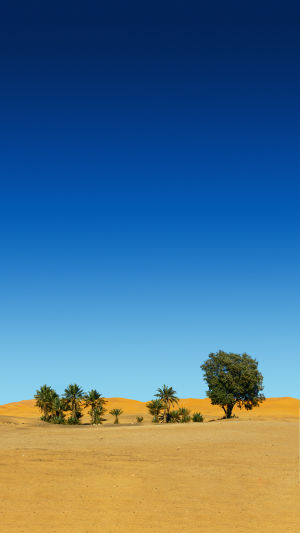Oasis are surprisingly attractive in deserts because of their stark contrast to the harsh surrounding landscape, where the transition from sand to greenery is often abrupt and "out of place" in these particular settings. Here are some picturesque oases in the world.
1. Oasis in the Ziz Valley (Morocco)
The Ziz Valley is the largest oasis in Morocco. This oasis is the most special of the many oases in the country and is often featured in movies. Even more amazing is the oasis of date palm trees that grow all the way to the Sahara Desert, and the barren hills and lush river valleys impress.
The town of Tafilalet is located in a river valley on the edge of palm groves.
Meanwhile, a small village called Aoufous is in the middle of the palm trees. The Ziz River supplies the oasis with a steady stream of water that eventually flows into the Sahara Desert.
Like the Nile on the other side of the African continent, the Ziz is also surrounded by agricultural environments, however, unlike its immediate neighbor Egypt, the Ziz gradually becomes intermittent once it reaches the easternmost deserts of Morocco and Algeria .
2. Huacachina Oasis (Peru)
Huacachina is located in the middle of the Peruvian desert dunes next to a natural lake. It is a popular tourist attraction in southern Peru, far from the capital Lima, and Machu Picchu. The closest city to Huacachina is Ica on the desert coast.
This desert region is one of the driest in the world in terms of total precipitation, yet it is surprising that all the oases in this region are intact. Huacachina has become a tourist destination, not only for Peruvians but also for international travelers.
Unfortunately, the lake level in the area has dropped a lot in recent years, and the problem is partly to blame on the local landowners, who, by digging wells, have reached the lake's water table, which has reduced inflow. The amount of water in the lake.
To address this, and to help Huacachina maintain its unique landscape (and tourist appeal), the government has diverted Ica's waters into the lake.
3. Bini Khalid Valley Oasis (Oman)
Part of Oman's Arabian Peninsula, the Bini Khalid Valley is one of the most accessible oases in the Arabian region, located between Muscat (the capital of Oman) and the highway connecting Sur.
Although the area is arid, the valley's streams and springs spring from the ground, and surrounding small villages and plantations are located near these water sources. Due to its relative accessibility, this place is hugely popular among domestic and foreign tourists.
4. Liwa Oasis (UAE)
Liwa Oasis is the largest oasis in Abu Dhabi (the capital of the United Arab Emirates, just north of Oman). Liwa is located on the edge of the sand dunes in the United Arab Emirates and Saudi Arabia, and is known as the "empty place". This 250,000-square-mile area is the largest continuous desertification area in the world.
Liwa Oasis is the last stop in this endless desert. An important economic pillar of Liwa remains agriculture, and technology uses traditional and modern methods such as drip irrigation.
However, with the number of tourists increasing in recent years, travelers everywhere have largely focused on desert sports like dune surfing and off-road driving, rather than visiting the oasis exclusively.
5. Chebir Oasis (Tunisia)
Chebir Oasis in Tunisia has everything an oasis fanatic would want: a cool climate, crystal clear swimming pools, palm trees, greenery and even waterfalls and rock formations. Most people who come to the western region of Tunisia focus on the barren lands beyond Chebiel.
The original "Star Wars" movie scenes were filmed near the Oasis of Sherby and the provincial capital of Tozeur. Thanks to the dry climate, these "movie sets" still look a lot like when they first appeared on the silver screen 40 years ago.
Meanwhile, scenes from Raiders of the Lost Ark and The English Patient were also filmed in the area.





